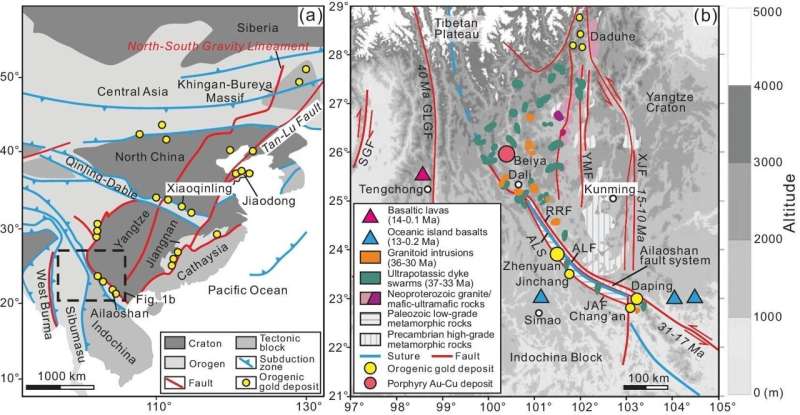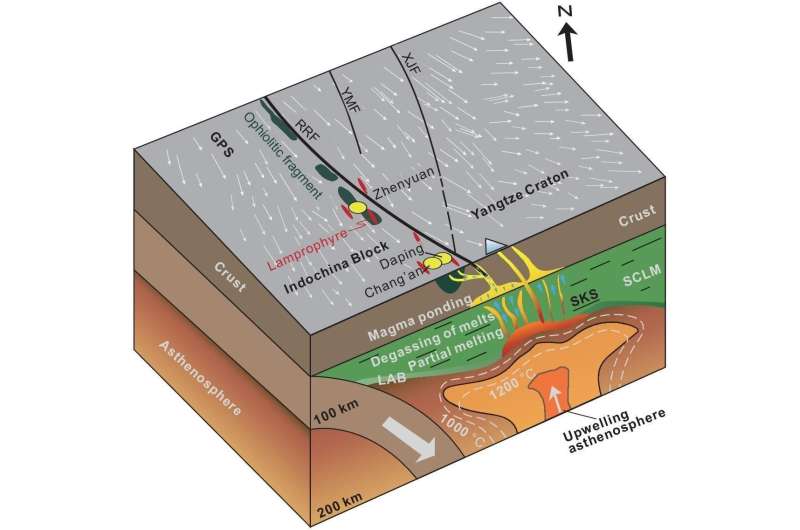This article has been reviewed according to Science X's editorial process and policies. Editors have highlighted the following attributes while ensuring the content's credibility:
fact-checked
proofread
Study: Lithosphere architecture controls the formation of orogenic gold deposits

Professor Zhang Haijiang from the School of Earth and Space Sciences, University of Science and Technology of China (USTC), in collaboration with academician Hou Zengqian from the Institute of Geology, Chinese Academy of Geological Sciences, and Professor Wang Qingfei from the China University of Geosciences (Beijing), have discovered that the lithosphere architecture characterized by crust-mantle decoupling controls the formation of orogenic gold belts. The research results were published in the National Science Review.
Orogenic gold deposits account for approximately 30% of the world's gold resources, but opinions about their mineralization mechanism are mixed. Such gold deposits were previously thought to have developed extensively in the Precambrian greenstone belt. And their gold-bearing fluids were considered to have been generated by the dehydration of crustal rocks during metamorphism. However, there is growing evidence for large amounts of epigenetic orogenic gold deposits on the margins of the Tertiary Craton, where the mineralizing fluids show substantial mantle origin.
The research team has chosen the Ailaoshan orogenic gold belt (Figure 1) on the western margin of the Yangzi Craton, located in the southeastern part of the Tibetan Plateau, as an example, and integrated various geophysical and geochemical tools to carry out a study on the orogenic gold belt mineralization mechanism.
According to the geological, geophysical, and geochemical data from the Ailaoshan gold mining area, the team proposed that lithospheric crust-mantle decoupling on the southeast margin of the Tibetan Plateau controls the formation of orogenic gold deposits and establishes a model for mineralization (Figure 2). Continental subduction triggered the upwelling of the soft current circle, partial melting of the mantle, and decoupling of the crust-mantle movement. The melt-generated basal magma converges at the crust-mantle decoupling and generates mineralizing fluids, which migrate along supra-crustal fractures to precipitate mineralization in the upper crust.

The geodynamic model of crust-mantle decoupling controlling gold mineralization can explain the formation of several large epigenetic orogenic gold provinces. The orogenic gold mineralization model proposed in this study can be useful for the integrated geophysical and geochemical investigation of similar gold systems.
This study is a continuation of the long-term geophysical advanced imaging algorithm development and related research on structural imaging in different regions by Prof. Zhang Haijiang's group. The group has developed a series of advanced geophysical imaging algorithms, including the joint imaging algorithms for seismic body wave travel time, surface wave dispersion, and receiver function, and constructed the high-resolution unified velocity model USTClitho1.0 and USTClitho2.0 for the Chinese continental lithosphere.
More information: Zengqian Hou et al, Lithosphere architecture characterized by crust–mantle decoupling controls the formation of orogenic gold deposits, National Science Review (2022). DOI: 10.1093/nsr/nwac257
Provided by University of Science and Technology of China



















